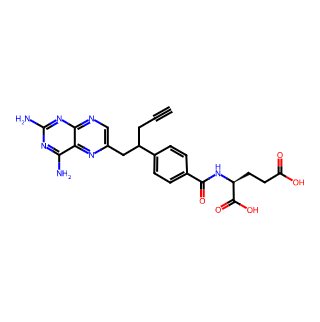- Synthetic anti-infective drugs
- Medications for the digestive system
- Antipyretic and analgesic drugs
- Medications for the blood system
- Medications for the respiratory system
- Anti-allergic drugs
- Medications for the urinary system
- Diagnostic medications
- Immunosuppressive and immunomodulatory drugs
- Vitamins and mineral supplements
- Antioxidants and medications for osteoporosis
- Antiparasitic drugs
- Ophthalmic medications
- Amino acids and their derivatives
- Dermatological medications
- Medications for the circulatory system
- Antitumor drugs
- Medications for the nervous system
- Hormonal and endocrine function-regulating drugs
- Antibiotics
- Others
CAS Number: 146464-95-1




Basic Information
Product Name: 10-Propargyl-10-deazaaminopterin
CAS Number: 146464-95-1
Chemical Formula: C23H23N7O5
Molecular Weight: 477.47 g/mol
Physical Properties
Appearance: White to light yellow to light orange powder or crystalline solid
Melting Point: 215°C (dec.)
Density: 1.471±0.06 g/cm³ (predicted)
Solubility:
Insoluble in water
Soluble in DMSO, with a solubility of ≥23.85 mg/mL
Insoluble in ethanol
Chemical Properties
Structure: Contains a propargyl group and a deazaaminopterin moiety
Stability: Stable under normal conditions, but should be stored in a cool, dry place to maintain optimal stability.
Biological Activity
Mechanism of Action: 10-Propargyl-10-deazaaminopterin is an antifolate drug with a structure similar to folate. It acts on certain cell lines and has an IC50 value below 300 nM. It can induce apoptosis of tumor cells by inhibiting dihydrofolate reductase (DHFR) and competitively inhibiting folylpolyglutamate synthetase polyglutamation, thereby blocking the synthesis of thymidine and other biomolecules dependent on one-carbon transfer. This interference with DNA synthesis leads to tumor cell death and therapeutic effects.
Pharmacodynamics: After administration, 10-Propargyl-10-deazaaminopterin is distributed and metabolized in the body, exerting its pharmacological effects through specific mechanisms.
Applications
Therapeutic Use: As an antitumor drug, 10-Propargyl-10-deazaaminopterin is the first drug to treat PTCL (peripheral T-cell lymphoma). It has shown efficacy in the treatment of recurrent and refractory PTCL when used alone.
Research Use: It is also used in scientific research to study its mechanisms of action, antitumor activity, and interactions with other drugs or biological systems.

Tai Yau Street, San Po Kong, Kowloon, Hong Kong, China.



